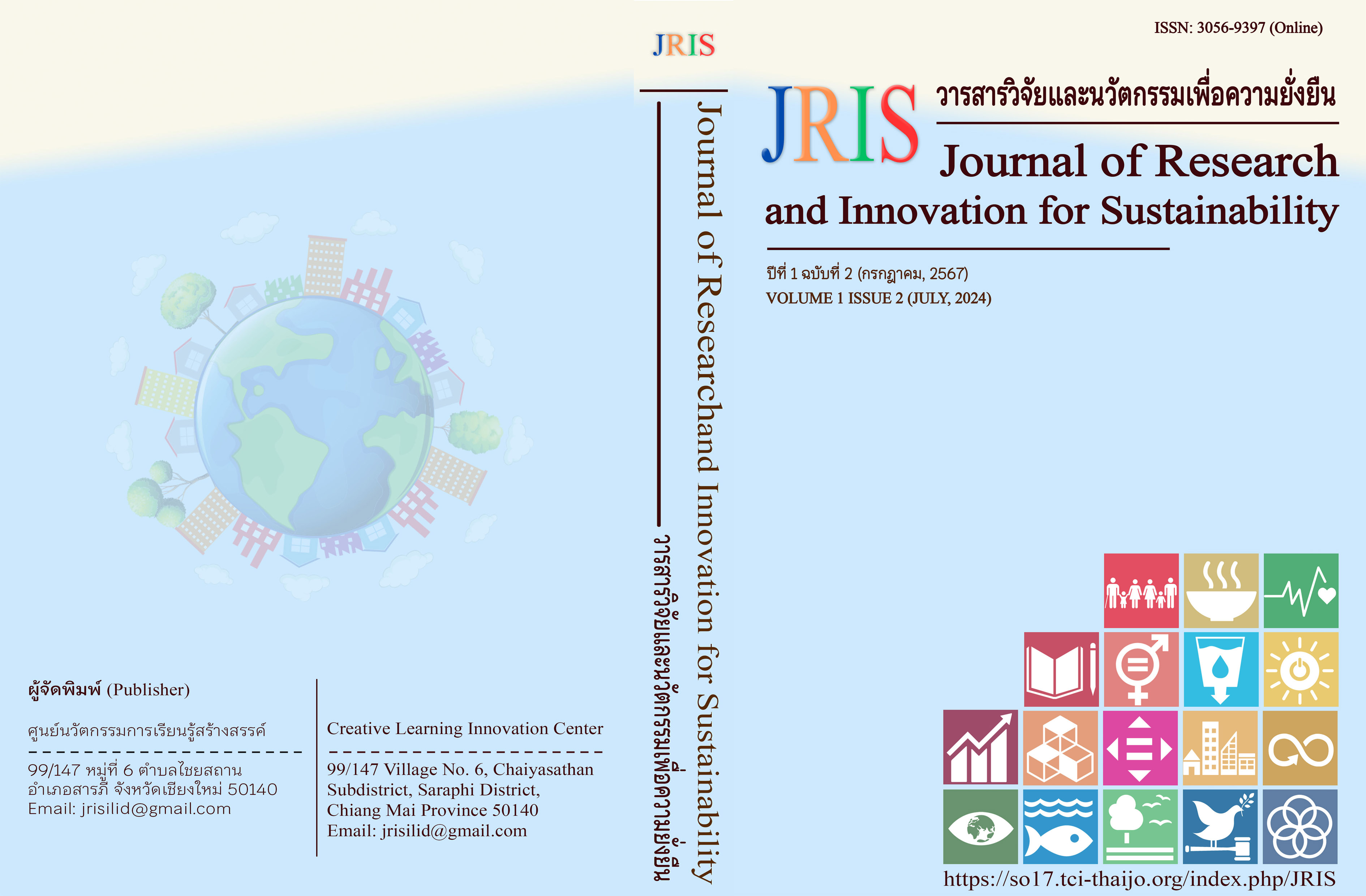STEM ACTIVITY IN SOCIO-CULTURAL CONTEXT: DEVELOPMENT OF PLANTERS FROM BANANA PSEUDO-STEMS FOR COMMUNITY PRODUCTS TO SUPPORT TOURISM IN PHA TAEM NATIONAL PARK, UBON RATCHATHANI PROVINCE
Main Article Content
Abstract
Students will play a key role in the future by helping to sustainably preserve and conserve the world's resources and communities. Therefore, Ban Kum School has the idea of organizing science learning activities using STEM education projects along with the BCG model concept, and implementing activities in the zero-waste school project. This initiative aims to develop products from natural materials within the community to mitigate issues stemming from garbage and leftovers. Additionally, this development promotes tourism and provides an alternative income stream. This research aims to investigate the proportions between banana pseudo-stems and suitable binding materials for molding with pre-made molds. It explores some physical properties of planters made from banana pseudo-stems and examines satisfaction with planters made from banana pseudo-stems. The study results indicate that the proportions between banana pseudo-stems and suitable binding materials for molding with pre-made molds can be successfully molded in all five experimental sets. The study results regarding some physical properties, including strength, indicate that all experimental sets perform well. Regarding water absorption and buoyancy, it was found that experimental set 4 has a higher water absorption rate than other ratios. As for heat absorption, experimental set 1 has a higher heat absorption rate than other ratios. The most suitable experimental set is set 4, which exhibits superior physical properties in terms of strength, water absorption, buoyancy, and heat absorption. Additionally, this experimental set has a lower binding material quantity. Overall, it received the highest level of satisfaction for planters made from banana pseudo-stems. The findings of the aforementioned study can address the community's requirements for managing agricultural waste issues, as well as the demand for novel and appealing products to offer to tourists visiting Pha Taem National Park. Moreover, it enables the analysis of the correlation between community products and the BCG economic model.
Article Details

This work is licensed under a Creative Commons Attribution-NonCommercial-NoDerivatives 4.0 International License.
Copyright License
Permission is granted to use text, content, images, or any other material from the publication for anyone who wishes to read, download, copy, distribute, print, search, or link to the full text of the article, compile data for indexing, transfer data to software, or use for any other legal purposes, provided that it is not used for commercial purposes or for business benefit. All articles published in the Journal of Research and Innovation for Sustainability are distributed under a Creative Commons Attribution-NonCommercial-NoDerivatives 4.0 International License: https://creativecommons.org/licenses/by-nc-nd/4.0/
References
กรมส่งเสริมคุณภาพสิ่งแวดล้อม. (2562). โรงเรียนปลอดขยะ (Zero Waste School). กระทรวงทรัพยากรธรรมชาติและสิ่งแวดล้อม.
กัญจนาภรณ์ เจริญผล, และอุบลวรรณ สุวรรณภูสิทธิ์. (2564). การสร้างและหาประสิทธิภาพถาดปลูกพืชจากมูลช้าง. วารสารวิชาการเทคโนโลยีอุตสาหกรรม มหาวิทยาลัยราชภัฏสุรินทร์, 6(2), 52-64.
จรีรัตน์ รวมเจริญ, กำธร เกิดทิพย์, และไพรัตน์ จีรเสถียร. (2564). สะเต็มศึกษาเพื่อการเรียนรู้ตลอดชีวิต: กรณีศึกษาเพื่อยกระดับผลิตภัณฑ์สร้างสรรค์จากกาบกล้วยเพื่อขับเคลื่อนเศรษฐกิจชุมชน. วารสารการศึกษาและนวัตกรรมการเรียนรู้, 1(2), 187-206.
จุฑามาศ แก้วมณี. (2564). การผลิตกระถางต้นไม้ย่อยสลายได้จากกากตะกอนโรงงานยางพาราร่วมกับวัสดุเหลือทิ้งจากก้อนเชื้อเห็ดและทะลายปาล์ม. ASEAN Journal of Scientific and Technological Reports, 24(1), 84-93.
ชาตรี ฝ่ายคําตา, ณภัทร สุขนฤเศรษฐกุล, สหรัฐ ยกย่อง, พงศธร ปัญญานุกิจ, ธาฤชร ประสพลาภ, กนกเทพ เมืองสง, จันทิมา นิลอุบล และณมน น่วมเจริญ. (2565). แนวคิดสะเต็มบีซีจีเพื่อการศึกษา. วารสารหน่วยวิจัยวิทยาศาสตร์ เทคโนโลยี และสิ่งแวดล้อมเพื่อการเรียนรู้, 13(2), 344-362.
เบญจมาศ ศิลาย้อย. (ม.ป.ป.). กล้วย: สารานุกรมไทยสำหรับเยาวชน. ม.ป.ท..
มลสุดา ลิวไธสง. (2556). การผลิตภาชนะย่อยสลายได้ทางชีวภาพจากกาบกล้วย [วิทยานิพนธ์วิศวกรรมศาสตรมหาบัณฑิต]. มหาวิทยาลัยเทคโนโลยีสุรนารี.
ศูนย์สะเต็มศึกษาแห่งชาติ. (2558). คู่มือเครือข่ายสะเต็มศึกษา. สถาบันส่งเสริมการสอนวิทยาศาสตร์และเทคโนโลยี.
สถาพร เรืองรุ่ง, นพรัตน์ เชื้อคำฮด, ชนากานต์ คูณแก้ว, ขวัญหทัย นาจารย์, และสุมาลิน ฝางคำ. (2566). การศึกษาอัตราส่วนระหว่างวัสดุทดแทน และวัสดุประสานที่เหมาะสมในการขึ้นรูปด้วยแม่พิมพ์สำเร็จรูป และคุณสมบัติทางกายภาพบางประการของกระถางจากวัสดุทดแทน. วารสารวิชชา มหาวิทยาลัยราชภัฏนครศรีธรรมราช, 42(2), 94-108.
สำนักงานพัฒนาวิทยาศาสตร์และเทคโนโลยีแห่งชาติ (สวทช.). (2564). BCG Economy Model. https://www.nstda.or.th/home/knowledge_post/what-is-bcg-economy-model/
สำนักนโยบายเศรษฐกิจมหภาค .(2565). ประมาณการเศรษฐกิจไทยปี 2565. https://www.mof.go.th/th/view/attachment/file/.pdf
สุทธิดา จำรัส. (2562). การออกแบบและพัฒนาสื่อและกิจกรรมการเรียนรู้สะเต็มเพื่อชีวิต เศรษฐกิจ และสังคม. วารสารวิชาการ Veridian E-Journal, Silpakorn University สาขามนุษยศาสตร์ สังคมศาสตร์และศิลปะ, 12(2), 1150-1170.

